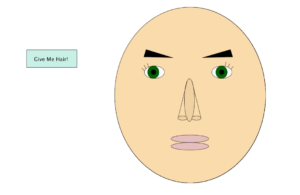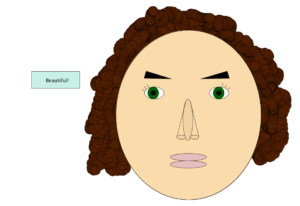
void setup () {
size(500, 430);
background(500, 500, 500);
}
void draw() {
noStroke();
fill(61, 49, 16);
ellipse(200, 210, 256, 384);
ellipse(200, 160, 257, 194);
ellipse(200, 190, 272, 170);
ellipse(200, 230, 277, 177);
ellipse(200, 260, 279, 197);
ellipse(200, 308, 283, 167);
ellipse(200, 348, 287, 167);
ellipse(200, 388, 287, 167);
// face ?
fill(240, 222, 195);
stroke(0,0,0);
ellipse(200, 180, 190, 275);
stroke(61, 49, 16);
strokeWeight(20);
line(150,315, 90, 230);
line(239,329, 310, 236);
//hair
noStroke();
fill(61, 49, 16);
//ellipse(240, 75, 65, 95);
arc(265, 44, 90, 150, 70, 190);
arc(275, 75, 60, 130, 60, 140);
arc(250, 35, 90, 130, 60, 170);
arc(215, 20, 50, 90, 60, 170);
arc(305, 130, 70, 110, 70, 190);
arc(179, 73, 90, 80, 160, 360);
arc(130, 95, 60, 60, 130, 330);
// neck ?
fill(227, 212, 191);
ellipse(200, 320, 100, 180);
//shirt
fill(98, 52, 158);
ellipse(200, 448, 350, 210);
//shirt
fill(227, 212, 191);
arc(200, 340, 110, 40, 20, 160);
fill(240, 222, 195);
ellipse(200, 240, 130, 170);
// nose
stroke(153, 141, 131);
strokeWeight(1);
arc(210, 213, 20, 30, 0, 70);
arc(185, 213, 20, 30, 100, 170);
arc(198, 230, 18, 10, 20, 170);
fill(0,0,0);
ellipse(187, 228, 2, 4);
ellipse(210, 228, 2, 4);
//lips
noStroke();
fill(207, 127, 127);
arc(198, 260, 48, 30, 10, 170);
arc(207, 264, 25, 15, 180, 350);
arc(190, 264, 25, 15, 180, 350);
stroke(61, 49, 16);
strokeWeight(2);
line(260,150, 240, 144);
line(135,150, 148, 145);
line(215,145, 240, 144);
line(148,145, 176, 144);
fill(250, 245, 250);
strokeWeight(1);
ellipse(160, 164, 32, 17);
ellipse(234, 164, 32, 17);
fill(107, 83, 68);
ellipse(234, 164, 18, 14);
ellipse(161, 164, 18, 14);
fill(0,0,0);
ellipse(234, 164, 11, 10);
ellipse(161, 164, 11, 10);



